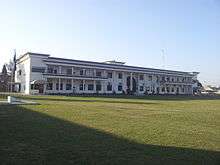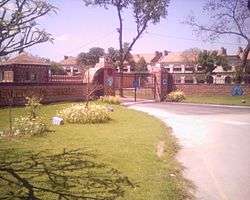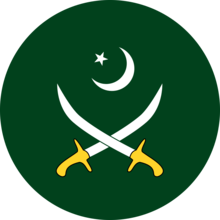Military College of Signals
The Military College of Signals, also known as MCS, is a co-educational military school located in Rawalpindi, Punjab, Pakistan. It is a constituent college of the National University of Sciences and Technology, Pakistan, Islamabad. MCS consists of two engineering departments. The college puts a strong emphasis on scientific and technological education and research.
| Motto | تیز و یقینی |
|---|---|
| Type | Military School |
| Established | 1947 |
| Rector | Lt Gen (Retd.) Naweed Zaman |
| Location | |
| Nickname | MCS |
| Affiliations | National University of Sciences and Technology, Pakistan Higher Education Commission (Pakistan) Pakistan Engineering Council |
| Mascot | Signalians |
| Website | nust |

It is located in the heart of Rawalpindi on Humayun Road (Lalkurti) and Adiala Road, close to the General Headquarters and Combined Military Hospital. The College is approximately 5 kilometres from the Benazir Bhutto International Airport and 3 kilometers from the Rawalpindi Railway Station. Prime shopping center of Saddar is about 2 kilometers from the college.
History

Military College of Signals was raised immediately after partition of the Indo-Pak Subcontinent in 1947 as "School of Signals", with the task of training officers and selected Non-Commissioned Officers of the Corps of Signals of Pakistan Army. The School had to be raised from a scratch because the signal training facilities of undivided Indian Army were located either at Poona or Jabalpur which became a part of India at the time of independence. Lt Col C.W.M. Young, a British Officer of the Royal Corps of Signals was the first commandant of the school. During the early years, due to the shortage of training facilities in the country in the field of telecommunication, a number of officers were trained at School of Signals, UK and subsequently at US Army Signal School at Fort Monmouth, New Jersey. The College, since its raising has undergone various phases of expansion to meet the requirements of the Corps of Signals.
The status of the school was raised to that of a college in 1977 when it was affiliated with University of Engineering and Technology, Lahore for Telecommunication Engineering degree program.
The college became a constituent campus of National University of Sciences and Technology in 1991 and since then it has progressed phenomenally as a center of quality education. Today the curriculum is not only confined to merely undergraduate level but also MS and PhD level.
Campus life
The college has kept military traditions alive. Military rules are applied and National University of Sciences and Technology, Pakistan (NUST) policy is followed too. It provides opportunities to participate in a variety of co-curricular activities. There are students' societies and clubs which organize different activities. Presently, the college has two societies. Both were established in June 2001.
- Telecom Society comprises the President, General Secretary, Treasurer, Project Coordinator and Media Coordinator. Elections are held every year.
- Software Society comprises the President(Ismaeel Moeen, Vice President, General Secretary, General Manager, Girls Representative, Extra-Curricular Activities Manager, Sports Manager, Finance Secretary, Event Secretary and EIT. This society on one hand has generated various extra curricular activities while on the other by organizing different seminars, workshops, lectures and short duration courses has contributed effectively to the academic development.
Organization and administration
The College of Signals is functionally and administratively controlled by the General Headquarters through Signals Directorate. It is headed by Major General/ Brigadier and is sub-divided into four functional groups.
- Administrative Wing (Adm Wing) Comprises Administrative Branch (Administration and Quartering Sections), Training Branch, NUST Branch, Examination Branch and MCS Training Battalion.
- Combat Wing (Cbt Wing) Comprises Tactical Branch, Telecommunication Branch, Security and Research Branch and Information Technology Branch.
- Engineering Wing (Engg Wing) Comprises Electrical Engineering, Computer Software Engineering, Information Security, Humanities and Basic Sciences Departments and Library.
- Research and Development Wing (R&D) Mostly focuses on research and development activities of the college.
Academics
Undergraduate program
MCS offers undergraduate degrees in two streams namely Electrical (Telecommunication) Engineering and Software Engineering.[1] Each year a standard NET (NUST Entrance Test) is conducted for the undergraduate enrollment in these courses. The students are also enrolled via SAT subject tests. Some students are also selected as Gentlemen Cadets of Pakistan army through ISSB. Moreover, wards of army personnel are also selected as PC's(Paying Cadets) and ASC's (Additional Selected Cadets).
Graduate program
The college also offers master degrees in Electrical (Telecommunication) Engineering, Software Engineering, Information Security and Systems Engineering. The master degrees also lead to PhD.[2] Students are enrolled after passing the GAT (Graduate Assessment Test).
Departments
The college has four departments.[3]
- Department of Computer Software Engineering (al-Khawarizmi Block)
- Department of Electrical Engineering (Shua ul Qamar Block)
- Department of Information Security
- Department of Humanities and Basic Sciences (Sharif Block), named after a veteran Signals Officer Major Sharif, who was also father of Major Shabbir Sharif, Nishan-e-Haider, the Highest Military Award of Gallantry and current Pakistan Army Chief General Raheel Sharif.
People
Students
There are seven different categories of students at college.
- Officers Pak Army Captains having served at least three and a half year after passing out from Pakistan Military Academy.
- Gentleman Cadets (GC's) Students who are enrolled in Pakistan Army. They enter the college after qualifying the ISSB Armed Forces selection test. Upon graduation from the college, the students spend one year at the Pakistan Military Academy to receive officer ranks. They undergo strict military training. They were also referred to as "Technical Cadets".
- NUST Cadets (NC's) Civilian students selected through the NUST entrance test. They do not undergo any sort of military training.
- Paying Cadets (PC's) The wards of serving military personnel are given a chance to come and study at MCS. They are the "Paying Cadets".They have to undergo military trainning and join Pakistan army as a captain for at least 3 years.
- Outreach Scholarship Cadets (OSPC's) Civilian students selected through the National ICT R&D Fund's Scholarship entrance test. These students achieve fully funded merit scholarship for 4 year degree program. They also do not undergo any sort of military training.
- Additional Selected Cadets (ASC's) This category is an extension of PC scheme. The cadet should be a ward of a retired or a serving military personnel. There are about 20-25 ASC reserved seats at MCS.
- Foreign Cadets (FC's) In addition, MCS also offers a limited number of seats to the international students. These cadets are mostly from Middle East.
Faculty
The rector of the college is Lieutenant General (Retd) Muhammad Asghar (pictured). MCS has about seventy faculty members who are responsible for teaching both graduate and undergraduate courses. Dr. Imran Rashid is the current Head of Electrical Department while Dr. Adnan Ahmed Khan heads the Department of Computer Science and Dr. Muhammad Ashiq is responsible for heading the Department of Humanities and Basic Sciences.[4]
See also
- National University of Science and Technology, Pakistan
- Pakistan Military Academy
- Army Medical College
- College of Aeronautical Engineering
- College of Electrical and Mechanical Engineering
- Military College of Engineering (Pakistan)
References
- http://nust.edu.pk/INSTITUTIONS/Colleges/MCS/ap/ug/Pages/default.aspx
- http://nust.edu.pk/INSTITUTIONS/Colleges/MCS/ap/pg/Pages/default.aspx
- http://nust.edu.pk/INSTITUTIONS/Colleges/MCS/Departments/Pages/default.aspx
- "Military College of Signals: Faculty". National University of Sciences and Technology. Retrieved 19 November 2017.
